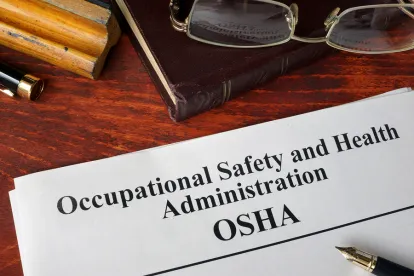On April 13, 2020, the Occupational Safety and Health Administration (‘OSHA”) of the U.S. Department of Labor issued a guidance memorandum (“Memorandum”) to its Area Offices and compliance safety and health officers for handling COVID-19 referrals, complaints, and severe illness reports.
The Memorandum articulates the procedures OSHA will use to prioritize enforcement responses, and details measures for protecting OSHA employees from the workplace hazard of SARS-CoV-2 (severe acute respiratory syndrome coronavirus 2), i.e., the virus causing the current COVID-19 pandemic, when conducting inspections. The Memorandum, which is “intended to be time-limited to the current public health crisis,” became effective immediately and will remain in effect until further notice.
The Memorandum restates the workplace risk levels described in OSHA’s Guidance on Preparing Workplaces for COVID-19, specifically:
-
High Exposure Risk: Workplaces and jobs with a high risk of exposures to COVID-19, which include, but are not limited to, hospitals treating suspected and/or confirmed COVID-19 patients; nursing homes; emergency medical centers; emergency response facilities; settings where home care or hospice care are provided; settings that handle human remains; biomedical laboratories, including clinical laboratories; and medical transport.
-
Medium Exposure Risk: Jobs with frequent and/or close contact with, i.e., within six feet of, people who may be (but are not known to be) infected with SARS-CoV-2.
-
Workers in this risk group may have frequent contact with travelers returning from international locations with widespread COVID-19 transmission.
-
In areas where there is ongoing community transmission, workers in this category, include, but are not limited to, those who have contact with the general public (g., in schools, high-population-density work environments, and some high-volume retail settings).
-
-
Lower Exposure Risk: Jobs that do not require contact with people known to be, or suspected of being, infected with SARS-CoV-2, nor frequent close contact with, i.e., within six feet of, the general public.
-
Workers in this category have minimal occupational contact with the public and other coworkers.
-
The Memorandum provides detailed instructions to its offices and field personnel on the safe conduct of COVID-19 investigations, both on-site and via remote means. For example, the Memorandum instructs that before commencing an investigation, OSHA’s area director (“AD”) should evaluate the exposure risk level at the workplace to determine whether on-site inspection is necessary or whether a remote investigation will suffice. If an on-site inspection is deemed necessary, the potential hazards must be carefully evaluated to limit any possible exposure(s). The Memorandum directs ADs to maximize the use of electronic means of communication such as “remote video surveillance, phone interviews, email correspondences, facsimile and email transmittals of documents, [and] video conferences” in conducting the inspection. The Memorandum also includes sample letters for initiating investigations, hazard alerts, and notices of violation.
The Memorandum explains that OSHA prioritizes the COVID-19 enforcement responses as follows:
-
Fatalities and imminent danger exposures related to COVID-19 will be prioritized for inspections, with particular attention given to health care organizations and first responders.
-
Formal complaints alleging unprotected exposures to COVID-19 for workers with a high/very high risk of transmission (such as a fatality that is potentially related to exposures to confirmed or suspected COVID-19 patients while performing aerosol-generating procedures without adequate personal protective equipment in a hospital) may warrant an on-site inspection.
-
-
All other formal complaints alleging SARS-CoV-2 exposure, where employees are engaged in medium or lower exposure risk tasks, as noted above, will not normally result in an on-site inspection, unless remote investigation does not provide adequate information from the employer.
For further information on ensuring an OSHA-compliant workplace during the COVID-19 pandemic, please see our “Summary of OSHA Guidance on Preparing Workplaces for COVID-19.”




 />i
/>i

